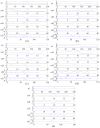Arrhythmia Classification Based on Multi-Domain Feature Extraction for an ECG Recognition System
- PMID: 27775596
- PMCID: PMC5087529
- DOI: 10.3390/s16101744
Arrhythmia Classification Based on Multi-Domain Feature Extraction for an ECG Recognition System
Abstract
Automatic recognition of arrhythmias is particularly important in the diagnosis of heart diseases. This study presents an electrocardiogram (ECG) recognition system based on multi-domain feature extraction to classify ECG beats. An improved wavelet threshold method for ECG signal pre-processing is applied to remove noise interference. A novel multi-domain feature extraction method is proposed; this method employs kernel-independent component analysis in nonlinear feature extraction and uses discrete wavelet transform to extract frequency domain features. The proposed system utilises a support vector machine classifier optimized with a genetic algorithm to recognize different types of heartbeats. An ECG acquisition experimental platform, in which ECG beats are collected as ECG data for classification, is constructed to demonstrate the effectiveness of the system in ECG beat classification. The presented system, when applied to the MIT-BIH arrhythmia database, achieves a high classification accuracy of 98.8%. Experimental results based on the ECG acquisition experimental platform show that the system obtains a satisfactory classification accuracy of 97.3% and is able to classify ECG beats efficiently for the automatic identification of cardiac arrhythmias.
Keywords: ECG recognition system; kernel-independent component analysis; multi-domain features; support vector machine.
Conflict of interest statement
The authors declare no conflict of interest.
Figures









Similar articles
-
Combining Low-dimensional Wavelet Features and Support Vector Machine for Arrhythmia Beat Classification.Sci Rep. 2017 Jul 20;7(1):6067. doi: 10.1038/s41598-017-06596-z. Sci Rep. 2017. PMID: 28729684 Free PMC article.
-
Feature extraction for ECG heartbeats using higher order statistics of WPD coefficients.Comput Methods Programs Biomed. 2012 Mar;105(3):257-67. doi: 10.1016/j.cmpb.2011.10.002. Epub 2011 Nov 3. Comput Methods Programs Biomed. 2012. PMID: 22055998
-
A cascaded classifier for multi-lead ECG based on feature fusion.Comput Methods Programs Biomed. 2019 Sep;178:135-143. doi: 10.1016/j.cmpb.2019.06.021. Epub 2019 Jun 20. Comput Methods Programs Biomed. 2019. PMID: 31416542
-
Application of deep learning techniques for heartbeats detection using ECG signals-analysis and review.Comput Biol Med. 2020 May;120:103726. doi: 10.1016/j.compbiomed.2020.103726. Epub 2020 Apr 8. Comput Biol Med. 2020. PMID: 32421643 Review.
-
Arrhythmia detection and classification using ECG and PPG techniques: a review.Phys Eng Sci Med. 2021 Dec;44(4):1027-1048. doi: 10.1007/s13246-021-01072-5. Epub 2021 Nov 2. Phys Eng Sci Med. 2021. PMID: 34727361 Review.
Cited by
-
Machine learning driven non-invasive approach of water content estimation in living plant leaves using terahertz waves.Plant Methods. 2019 Nov 18;15:138. doi: 10.1186/s13007-019-0522-9. eCollection 2019. Plant Methods. 2019. PMID: 31832080 Free PMC article.
-
Efficient Lightweight Multimodel Deep Fusion Based on ECG for Arrhythmia Classification.Sensors (Basel). 2022 Dec 1;22(23):9347. doi: 10.3390/s22239347. Sensors (Basel). 2022. PMID: 36502049 Free PMC article.
-
On the Design of an Efficient Cardiac Health Monitoring System Through Combined Analysis of ECG and SCG Signals.Sensors (Basel). 2018 Jan 28;18(2):379. doi: 10.3390/s18020379. Sensors (Basel). 2018. PMID: 29382098 Free PMC article.
-
Investigating the effect of traditional Persian music on ECG signals in young women using wavelet transform and neural networks.Anatol J Cardiol. 2017 May;17(5):398-403. doi: 10.14744/AnatolJCardiol.2016.7436. Epub 2017 Jan 17. Anatol J Cardiol. 2017. PMID: 28100896 Free PMC article.
-
Deep Learning-Based Electrocardiogram Signal Noise Detection and Screening Model.Healthc Inform Res. 2019 Jul;25(3):201-211. doi: 10.4258/hir.2019.25.3.201. Epub 2019 Jul 31. Healthc Inform Res. 2019. PMID: 31406612 Free PMC article.
References
-
- Edla S., Kovvali N., Papandreou-Suppappola A. Electrocardiogram signal modeling with adaptive parameter estimation using sequential bayesian methods. IEEE Trans. Signal Process. 2014;62:2667–2680. doi: 10.1109/TSP.2014.2312316. - DOI
-
- Wang J., She M., Nahavandi S., Kouzani A. Human identification from ECG signals via sparse representation of local segments. IEEE Signal Process. Lett. 2013;20:937–940. doi: 10.1109/LSP.2013.2267593. - DOI
-
- Ubeyli E.D. Combining recurrent neural networks with eigenvector methods for classification of ECG beats. Digit. Signal Process. 2009;19:320–329. doi: 10.1016/j.dsp.2008.09.002. - DOI
-
- Jain S., Bajaj V., Kumar A. Efficient algorithm for classification of electrocardiogram beats based on artificial bee colony-based least-squares support vector machines classifier. Electron. Lett. 2016;52:1198–1200. doi: 10.1049/el.2016.1171. - DOI
MeSH terms
LinkOut - more resources
Full Text Sources
Other Literature Sources
Medical

